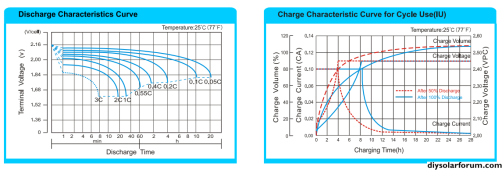rhythmstick
New Member
Hiya everyone,
I'm relatively new to solar. This is my system (on a boat with no other means of charging):
I've read this thread, which is what prompted me to sign up. I've also done other looking around and got in touch with the suppliers of the battery, but I'm not confident that my settings are right, so I'm hoping someone on here will be able to advise me if any of these values need tweaking.
So, these are my current settings:
Batt. Type:
User
Batt. AH:
260AH
Temp Comp. Coeff / Temperature Compensation Coefficient:
-3mv/degC/2V
...should this be -3mV (ie, the float charging voltage temp. coefficient) or should it be -4mv (ie, the cycle use voltage temp. coefficient) ?
Rated Voltage:
Auto
Over Volt. Disc. / Over Voltage Disconnect Voltage:
15.1 V
...was advised to keep this down, as close to 15.0v as I could.
Charge Limit:
15.0 V
Over Volt. Rec. / Over Voltage Reconnect Voltage:
15.0 V
Equal. Charge / Equalize Charging Voltage:
14.8 V
Boost Charge:
14.8 V
...this is the upper limit of the battery spec's 14.6v to 14.8v range.
Float Charge:
13.8 V
...this is the upper limit of the battery spec's 13.6v to 13.8v range.
Boost Rec. / Boost Reconnect Charging Voltage:
13.2 V
Low Volt. Rect. / Low Voltage Reconnect Voltage:
12.6 V
Under Volt. Rect / Under Voltage Warning Reconnect Voltage:
12.2 V
Under Volt. Warn / Under Voltage Warning Voltage:
12.1 V
Low Voltage. Disc. / Low Voltage Disconnect Voltage:
12.1 V
Discharge Limit:
12.1 V
...apparently, for AGM batteries, 12.1v corresponds to a discharge level of 50%.
Equalize Time:
0min
Boost Time:
120min
Can anyone confirm if these settings are correct? Or are there any tweaks I can make?
Big thank you in advance!
Cheers,
James
I'm relatively new to solar. This is my system (on a boat with no other means of charging):
- Epever Tracer 4210AN (with an MT50)
- 3 x 200w panels
- 1 x 260 Ah AGM battery (specs here)
I've read this thread, which is what prompted me to sign up. I've also done other looking around and got in touch with the suppliers of the battery, but I'm not confident that my settings are right, so I'm hoping someone on here will be able to advise me if any of these values need tweaking.
So, these are my current settings:
Batt. Type:
User
Batt. AH:
260AH
Temp Comp. Coeff / Temperature Compensation Coefficient:
-3mv/degC/2V
...should this be -3mV (ie, the float charging voltage temp. coefficient) or should it be -4mv (ie, the cycle use voltage temp. coefficient) ?
Rated Voltage:
Auto
Over Volt. Disc. / Over Voltage Disconnect Voltage:
15.1 V
...was advised to keep this down, as close to 15.0v as I could.
Charge Limit:
15.0 V
Over Volt. Rec. / Over Voltage Reconnect Voltage:
15.0 V
Equal. Charge / Equalize Charging Voltage:
14.8 V
Boost Charge:
14.8 V
...this is the upper limit of the battery spec's 14.6v to 14.8v range.
Float Charge:
13.8 V
...this is the upper limit of the battery spec's 13.6v to 13.8v range.
Boost Rec. / Boost Reconnect Charging Voltage:
13.2 V
Low Volt. Rect. / Low Voltage Reconnect Voltage:
12.6 V
Under Volt. Rect / Under Voltage Warning Reconnect Voltage:
12.2 V
Under Volt. Warn / Under Voltage Warning Voltage:
12.1 V
Low Voltage. Disc. / Low Voltage Disconnect Voltage:
12.1 V
Discharge Limit:
12.1 V
...apparently, for AGM batteries, 12.1v corresponds to a discharge level of 50%.
Equalize Time:
0min
Boost Time:
120min
Can anyone confirm if these settings are correct? Or are there any tweaks I can make?
Big thank you in advance!
Cheers,
James




